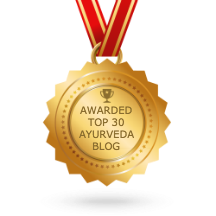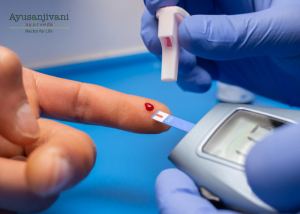Table of Contents
ToggleComprehensive Guide to Migraine Headache: Causes, Symptoms, Types, and Ayurvedic Treatment
Introduction :
Migraine headche is a recurring neurological condition that presents as intense, pulsating headaches, often accompanied by nausea, vomiting, and sensitivity to light or sound. It significantly affects quality of life and daily functioning. Ayurveda identifies migraine as Ardhavabhedaka, a type of headache disorder rooted in doshic imbalances—primarily Vata and Pitta.

Causes of Migraine headache :
Modern Perspective:
- Hormonal fluctuations (e.g., menstruation)
- Stress or emotional triggers
- Irregular meals or sleep patterns
- Certain foods (cheese, chocolate, caffeine)
- Weather changes
- Sensory triggers (bright lights, strong smells)
Ayurvedic Perspective:
- Aggravation of Vata and Pitta dosha
- Improper diet (viruddha ahara)
- Suppression of natural urges (vegadharana)
- Excessive mental strain
- Poor sleep or excessive sleep (nidra dosha)
Types of Migraine headahe :
| Type | Features |
|---|---|
| Migraine with Aura | Visual disturbances (flashes, zigzag lines) before pain |
| Migraine without Aura | Common type; headache starts suddenly |
| Chronic Migraine | Occurs 15+ days per month |
| Menstrual Migraine | Linked to hormonal changes during menstruation |
| Vestibular Migraine | Includes vertigo, dizziness |
| Hemiplegic Migraine | Temporary weakness on one side of the body |
Symptoms of Migraine headche :
- Unilateral or bilateral throbbing headache
- Nausea or vomiting
- Sensitivity to light (photophobia) and sound (phonophobia)
- Visual disturbances (scotomas, flashes)
- Fatigue and irritability
- Neck stiffness or heaviness in the head
Grades of Migraine Severity :
| Grade | Description | Impact on Life |
|---|---|---|
| I | Mild: manageable without medication | Rare impact on daily activities |
| II | Moderate: requires rest or medication | Disrupts work or concentration |
| III | Severe: bedridden, nausea present | Unable to function normally |
| IV | Chronic and disabling migraine | Severe disability; frequent attacks |
Clinical Investigations :
To rule out other causes and confirm diagnosis:
- Neurological exam
- MRI / CT Scan – to rule out structural brain issues
- EEG – if seizures are suspected
- Hormonal Profile – especially in menstrual migraine
- Trigger Diary – helps identify lifestyle and food-based triggers
Ayurvedic View: Ardhavabhedaka
Nidana (Causative Factors) :
- Ratri jagarana (night awakening)
- Amla, katu, lavana rasa-sevana (sour, pungent, salty foods)
- Shoka, chinta, bhaya (emotions)
- Vega dharana (suppressing natural urges)
Samprapti (Pathogenesis) :
Vata and Pitta vitiation affect the shiras (head region), leading to intense unilateral pain, especially near temples, eyes, and forehead.
Ayurvedic Treatment for Migraine :
Shodhana (Detox Therapies)
| Panchakarma | Purpose |
|---|---|
| Virechana | Clears excess pitta from the system |
| Nasya | Removes dosha from head region |
| Shirodhara | Calms the nervous system |
Shamana (Palliative Therapy)
| Medicine Name | Function |
|---|---|
| Pathyadi Kadha | Classical remedy for headaches |
| Godanti Bhasma | Reduces heat and pitta |
| Shirashooladi Vajra Ras | Effective for vascular headaches |
| Ashwagandha Churna | Adaptogen; reduces stress |
| Brahmi Vati | Calms the mind and improves sleep |
Note: Always consult an Ayurvedic physician for personalized dosage and selection.
Home Remedies Chart :
| Remedy | Preparation & Use |
|---|---|
| Ginger Tea | Boil ginger in water; relieves nausea & inflammation |
| Peppermint Oil Massage | Apply gently on temples for cooling effect |
| Cow Ghee Nasya | 2 drops warm ghee in nostrils (under guidance) |
| Amla Juice | Daily in the morning; reduces pitta |
| Dry Fomentation (Nadi Swedana) | Apply on neck/head for vata relief |
Diet & Lifestyle Tips :
- Follow regular sleep-wake cycles
- Avoid processed, sour, and fried foods
- Reduce screen time and eye strain
- Perform daily meditation or deep breathing
- Practice yoga asanas like Balasana, Vajrasana, and Shavasana
Frequently Asked Questions (FAQs) :
Q1. Can Ayurveda cure migraine permanently?
Ayurveda focuses on correcting the root cause. With detox, internal medicines, and lifestyle changes, long-term relief and even cure are possible in many cases.
Q2. Is Panchakarma necessary for every migraine patient?
Not always. It is recommended in chronic or pitta-vata dominant cases. Mild cases may respond well to shamana therapy alone.
Q3. How long does Ayurvedic treatment take to show results?
Initial relief may begin within 2–4 weeks, but complete treatment may take 3–6 months depending on chronicity.
Q4. Can migraine be a symptom of other diseases?
Yes. Conditions like sinusitis, hypertension, brain tumors, or eye strain can mimic migraine. Proper diagnosis is essential.
Q5. Is migraine hereditary?
It can run in families, but environmental and lifestyle factors are equally important triggers.
Take away message for migraine headache :
Migraine is not just a headache—it reflects a deeper systemic imbalance. Ayurveda offers a time-tested, personalized approach to manage and potentially reverse migraine through detoxification, herbal support, dietary correction, and stress management. At Ayusanjivani Ayurveda Clinic, we specialize in treating migraine holistically, targeting the root cause for lasting relief.
book appointment today only.





